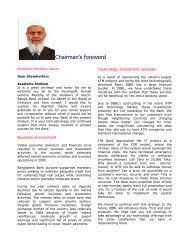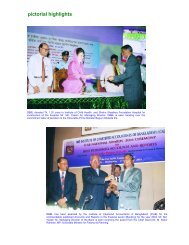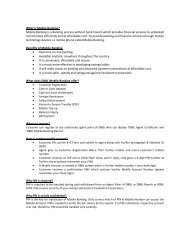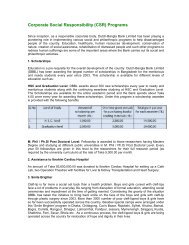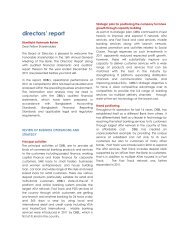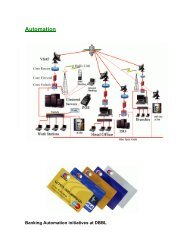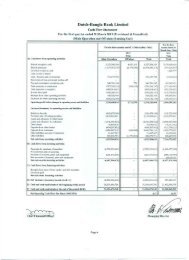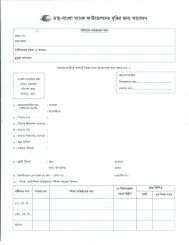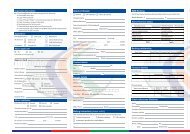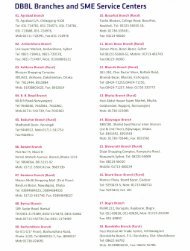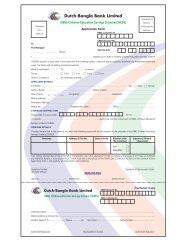directors' report - Dutch-Bangla Bank Limited
directors' report - Dutch-Bangla Bank Limited
directors' report - Dutch-Bangla Bank Limited
Create successful ePaper yourself
Turn your PDF publications into a flip-book with our unique Google optimized e-Paper software.
A 100% compliant export-oriented<br />
denim fabric manufacturing Industry<br />
at Comilla EPZ financed by DBBL.<br />
A partial view of 100% export-oriented<br />
embroidery factory at Fotullah, Narayanganj<br />
financed by DBBL.<br />
<strong>directors'</strong> <strong>report</strong><br />
Bismillahir Rahmanir Rahim<br />
Dear Fellow Shareholders<br />
The Board of Directors is pleased to welcome the<br />
honorable shareholders in the 12th Annual General<br />
Meeting of the <strong>Bank</strong>. The Directors' Report along<br />
with audited financial statements and auditors'<br />
<strong>report</strong> thereon for the year ended December 31,<br />
2007 are presented before your kind-self.<br />
In the <strong>report</strong>, DBBL's operational performance of<br />
2007 as compared to 2006 have been evaluated<br />
and analyzed within the prevailing business<br />
environment. The information and analysis may be<br />
read in conjunction with the DBBL's audited<br />
financial statements which have been prepared in<br />
accordance with <strong>Bangla</strong>desh Accounting Standards<br />
and applicable legal and regulatory requirements.<br />
State of the <strong>Bangla</strong>desh economy<br />
GDP growth<br />
<strong>Bangla</strong>desh economy achieved a real GDP growth<br />
of 6.5% in FY 2007 slightly lower than 6.6% of FY<br />
2006. The growth was commendable as it was<br />
achieved in a challenging environment marked by<br />
high and volatile oil prices in international market,<br />
labor unrest in the garment industry and<br />
confrontational political situation of the country in<br />
the first half of FY 2007. At current market price<br />
GDP of <strong>Bangla</strong>desh in FY 2007 was estimated at<br />
Taka 4,675.00 billion. The strong growth was<br />
underpinned mainly by robust growth in services<br />
and notable expansion in manufacturing activities.<br />
Economic growth was also aided by increased<br />
inflow of workers' remittances from abroad and<br />
reasonable growth in exports.<br />
The industry sector attained robust growth of 9.5%<br />
in FY 2007, slightly lower than 9.7% of FY 2006.<br />
The growth was supported by a continued<br />
improved performance in manufacturing sub-sector,<br />
facilitated by strong and sustained growth in exportoriented<br />
manufacturing activities and expansion in<br />
domestic demand. Overall the service sector grew<br />
by 6.7% in FY 2007, higher than 6.4% recorded in<br />
FY 2006 and remaining above the growth in FY
2007. Agriculture sector achieved a moderate growth of 3.2% in FY 2007 following the post flood<br />
high growth of 4.9% in FY 2006, resulting mainly from a lower growth in crops and horticulture subsector.<br />
The long term trend showing a shift of sectoral composition of GDP away from agriculture<br />
towards industry continued in FY 2007 while the share of industry sector increased to 29.8% from<br />
29.0% , the share of agriculture sector in GDP came down to 21.1% from 21.8% ; the share of the<br />
service sector in GDP also slightly declined to 49.1% from 49.2%.<br />
Government and <strong>Bangla</strong>desh <strong>Bank</strong> policy towards economic development<br />
With a view to achieving higher economic growth, the Government and <strong>Bangla</strong>desh <strong>Bank</strong> continued<br />
to adopt policies to support economic activities to the highest sustainable level while maintaining a<br />
moderate CPI inflation. The fiscal policy in FY 2007 was geared to accelerate economic growth<br />
and create employment opportunities and promoting private sector investment. The Government<br />
pursued a set of strategies which were attuned to the poverty issues. These strategies included,<br />
among others, increasing allocation in education, health and other sectors; ensuring financial<br />
security of the disadvantaged by widening social safety nets; ensuring economic good governance<br />
and enhancing public management capacity. <strong>Bangla</strong>desh <strong>Bank</strong> continued to pursue a cautiously<br />
restrained monetary policy stance with the prime objective of keeping inflationary pressure under<br />
control while supporting the targeted real output growth during FY 2007.<br />
External sector<br />
Exports and imports achieved robust and reasonable growth in FY 2007, and remittances from<br />
workers abroad showed a strong and steady growth in FY 2007. Export increased by 15.8% from<br />
US$ 10,412.00 million in FY 2006 to US$ 12,053 .00 million in FY 2007 while imports increased by<br />
16.6% from US$ 13,301.00 million to US$ 15,511.00 million. At the same time remittance increased<br />
by 24.5% from US$ 4,802.00 million in FY 2006 to US$ 5,979.00 million in FY 2007. As a result<br />
country's current account balance exhibited a notable surplus of US$ 952 million in FY 2007 from<br />
US$ 572.00 million in FY 2006. The overall balance of payments also recorded significant surplus<br />
of US$ 1,493 million in FY 2007 compared to US$ 365.00 million in FY 2006.Gross foreign<br />
exchange reserve increased by US$ 1,593.00 million to US$ 5,077.00 million at the end of FY 2007<br />
that was equivalent to 3.9 months' import.<br />
Inflation<br />
The rising trend of inflation measured by CPI continued during FY 2007. The expanding pressure<br />
of domestic demand supported by continued high monetary and credit growth, increase in<br />
international prices of major consumer goods particularly food and petroleum products, adjustment<br />
in domestic fuel price, price manipulation through business syndication and loss of business<br />
confidence resulting from anti corruption and anti hoarding drive in the country contributed to<br />
inflation spirals. Annual average inflation measured by 12-months average movements in CPI,<br />
marginally increased from 7.16% in June 2006 to 7.20% in June 2007. while 12-month consumer<br />
price inflation on a point-to-point basis increased to 9.2 % from 7.5% over the same period.
A partial view of 100% export-oriented<br />
embroidery factory at Fotullah, Narayanganj<br />
financed by DBBL.<br />
Savings and investments<br />
Domestic savings -GDP ratio rose from 20.3% in FY<br />
2006 to 20.5% in FY 2007 while investment -GDP<br />
ratio decreased from 24.7% of FY 2006 to 24.3% in<br />
FY 2007. Savings -investment gap of 3.8% was<br />
financed by net factor income from abroad.<br />
Pubic Finance<br />
Revenue receipts in FY 2007 were Taka 494.7 billion,<br />
10.3% higher than revenue of Taka 448.7 billion in<br />
FY 2006. Tax revenue was 79.3% within total<br />
revenue. Public expenditure amounted to Taka 668.4<br />
billion in FY 2007, 9.5% higher than Taka 610.6<br />
billion in FY 2006. Public expenditure comprised of<br />
Taka 420.6 billion current expenditure and Taka<br />
216.0 billion development expenditure which was<br />
reduced by 16.9% from original target of Taka 260.0<br />
billion due to less than the expected amount of<br />
resources received from external sources. The deficit<br />
in revised FY 2007 budget stood at Taka 173.7 billion<br />
or 3.7% of GDP at current prices. The domestic<br />
borrowing component of the deficit financing was<br />
Taka 100.3 billion (2.1% of GDP) in FY 2007 in which<br />
bank borrowing was Taka 65.3 billion (1.4% of GDP).<br />
Revenue as a percentage of GDP declined to 10.6%<br />
as compared to 10.8% in FY 2006. While public<br />
expenditure as a percentage of GDP declined from<br />
14.7% in FY 2006 to 14.3% in FY 2007. Accordingly<br />
overall budget deficit declined from 3.9% of GDP in<br />
FY 2006 to 3.7% in FY 2007 reflecting strict fiscal<br />
discipline and cutting wasteful expenditure through<br />
austerity measures.<br />
Future outlook for the <strong>Bangla</strong>desh economy<br />
In view of medium term outlook of sustainable<br />
economic growth and low inflation for world and<br />
South Asian economies and assuming continuation of<br />
prudent policies and progress in advancing structural<br />
reforms, the near and medium term economic<br />
prospects of <strong>Bangla</strong>desh appear favorable. In the<br />
updated Medium Term Macroeconomic Framework<br />
(MTMF) of PRSP entitled 'Unlocking the Potential:<br />
National Strategy for Accelerated Poverty Reduction',<br />
real GDP growth has been projected to increase to<br />
7.0% in FY 2008 and sustaining at or above 7.0%<br />
through FY 2010 .<br />
Improved macroeconomic stability and intrinsic<br />
resilience, buoyancy in overall agricultural sector<br />
growth, steady growth in the manufacturing sector,<br />
competitive business environment and sustained
improvement in the investment climate, and ongoing implementation of economic reform programs<br />
including SOE and NCB reforms are essential preconditions for above-noted growth targets. To<br />
support the pro-poor growth targets envisaged in the MTMF, the gross domestic investment is<br />
projected to increase gradually through mobilization of internal and foreign resources. Inflation is<br />
projected to decline with an appropriately cautious restrained monetary policy stance towards<br />
maintaining price stability coupled with the support of prudent fiscal and trade policies.<br />
The rising inflationary pressures, the sustained high global oil prices, under-pricing of energy<br />
products, infrastructure constraints (especially power, ports, and transportation) , probable adverse<br />
effects in the RMG sub-sector from 2008 onwards due to expiry of restriction imposed on China ,<br />
restoring business confidence for strengthening private sector investment activities , and the<br />
political developments and outcome of the next general elections scheduled to be held within 2008<br />
remain major challenges for the economy in near future. Apart from these risks, economic<br />
prospects in near and medium term particularly in FY 2008 are likely to be affected by the repeated<br />
floods and cyclone Sidr.<br />
Money, Credit and Financial Market<br />
Money and credit growth<br />
Despite the restrained monetary policy stance adopted by <strong>Bangla</strong>desh <strong>Bank</strong>, Broad money grew by<br />
17.1% in FY 2007 which was lower than 19.3% growth in FY 2006 while domestic credit grew by<br />
14.5% lower than 21.1% growth in FY 2006. Credit to the private sector increased by 15.1%<br />
compared to 18.3% in FY 2006 reflecting lower demand for credit resulting from declining business<br />
confidence prevailing in the economy. Public sector credit grew by 12.5 % compared to 30.6% in<br />
FY 2006 mainly due to downsizing of ADP.<br />
Monetary policy stance and interest rate scenario<br />
<strong>Bangla</strong>desh <strong>Bank</strong> continued to pursue a cautiously restrained monetary policy stance with the<br />
prime objective of keeping inflationary pressure under control while supporting the targeted real<br />
output growth during FY 2007. In line with this policy stance, an upward bias in the policy interest<br />
rate and reintroduction of BB bills in October 2006 succeeded in limiting inflation around the<br />
targeted level up to January 2007. Besides, repo and reverse repo interest rates and treasury<br />
bill/bond yield rates were maintained on sustained up trend during the year in an attempt to<br />
slowdown credit growth.<br />
The declining trend of interest rates that persisted over a couple of years till FY 2005 reversed in<br />
FY 2006 which continued in FY 2007. Weighted average interest rate on bank credit increased to<br />
12.8% at the end of June 2007 from 12.1% at the end of June 2006. The weighted average interest<br />
rate on bank deposits recorded a modest increase to 6.9% from 6.7% in the same period. As a<br />
result, net spread between advances and deposits increased to 5.9% from 5.4%.<br />
Money market<br />
Efficient monetary operation, especially use of shorter term monetary instruments such as reverse<br />
repo and reintroduction of <strong>Bangla</strong>desh <strong>Bank</strong> Bills helped keep the money market sound and stable<br />
during the FY 2007. Steps towards activation of secondary trading in treasury bills/bonds were also
A medical equipment at a reputed hospital<br />
financed by DBBL<br />
A partial view of cycle manufacturing industry<br />
financed by DBBL.<br />
continued. As a result, the overall money market<br />
situation was stable and sound during FY 2007. The<br />
weighted average interest rates in call money market<br />
witnessed stability in FY 2007 as against a degree of<br />
fluctuation in FY 2006. The weighted average interest<br />
rate moved within the range of 6.9% to 7.7% during<br />
FY 2007. This may be due to excess liquidity in the<br />
market resulting from lower growth of demand for<br />
credit in the private sector as compared to the<br />
preceding year and huge inflow from export earnings<br />
and workers' remittance.<br />
The repo injects required money in the system and<br />
provides banks with necessary funds to maintain their<br />
liquidity. While pursuing a cautious monetary policy,<br />
<strong>Bangla</strong>desh <strong>Bank</strong> kept this window open for the<br />
banks to maintain the market liquidity at desired level.<br />
The weighted average interest rates on repo auctions<br />
ranged from 9.0% to 9.3% per annum in FY 2007 (<br />
8.0% to 8.5% in FY 2006). While repo injects money<br />
in the system, the reverse repo takes it away from the<br />
system. As a counterpart of repo auctions, the<br />
reverse repo auctions continued in FY 2007. The<br />
reverse repo auctions were used to maintain intended<br />
level of liquidity in the market as well as to contain<br />
credit growth. The weighted average interest rates on<br />
reverse repo auctions ranged from 6.1% to 6.5% per<br />
annum in FY 2007 as against 4.5% to 6.5% per<br />
annum in FY 2006.<br />
A carefully coordinated operation of repo and reverse<br />
repo transactions along with auction of <strong>Bangla</strong>desh<br />
<strong>Bank</strong> bills played a key role in stabilizing the interest<br />
rates in banking sector during FY 2007.<br />
Foreign exchange market<br />
<strong>Bangla</strong>desh <strong>Bank</strong> introduced floating exchange rate<br />
in May 2003 for Taka. Under the arrangement the<br />
banks are free to set their own rates for inter-bank<br />
and customer level transactions. Taka is fully<br />
convertible for current international transactions.<br />
Repatriation of profits or disinvestment proceeds on<br />
non-resident FDI and portfolio investments are freely<br />
permitted. The exchange rate is being determined in<br />
the market on the basis of market demand and<br />
supply forces of the respective currencies. However<br />
BB occasionally intervenes in the market when it<br />
deems necessary to maintain stability in the foreign<br />
exchange market designed to ensuring the
competitiveness of <strong>Bangla</strong>deshi products in the international markets, encouraging inflow of<br />
remittances, maintaining internal price stability and maintaining balance in external account<br />
position.<br />
At the floating regime exchange rate remained somewhat stable against major international<br />
currencies. However in 1st half of 2007 foreign exchange market experienced substantial<br />
pressure on demand side created by continued price hike for import of oil and petroleum<br />
products, and other major import commodities in the world market coupled with higher growth in<br />
lending to the private sector which led to higher demand for import of capital machinery.<br />
However, due to adoption of cautious monetary policy by <strong>Bangla</strong>desh <strong>Bank</strong> together with<br />
substantial inflow of foreign exchange from export earnings and remittances the situation eased<br />
later on and at the end of FY 2007 Taka-Dollar exchange rate remained stable within a range of<br />
Taka 68.70 to Taka 69.30.<br />
Remittance<br />
Over the last few years various steps have been taken to boost the flow of remittance through the<br />
banking channel. These include expansion of activities of drawing arrangements, review of<br />
statements received from foreign banks /exchange houses, close monitoring and supervision of<br />
banks. Besides, scheduled banks have ensured quick delivery of remittances by reducing leadtime<br />
to the beneficiaries in <strong>Bangla</strong>desh, which brought substantial development in the delivery<br />
system. As a result, remittances increased by 24.5% from US $ 4,801.9 million in FY 2006 to US$<br />
5,978.5 in 2007.<br />
Capital market<br />
The capital market witnessed a vintage year in 2007 raising the total market capitalization to GDP<br />
ratio to 15.88 % against 7.59% of 2006. Total market capitalization crossed US $ 10 billion -mark<br />
in 2007. DSE Market capitalization stood at Taka 74,220 crore on December 30, 2007 while it<br />
was Taka 31,066 crore on January 03, 2007. Heavy inflow of liquidity and entry of fresh investors<br />
pulled the stock market to its record height in 2007. Institutional investors this year channeled<br />
huge funds into the market. The benchmark General Index climbed to 3093.54 points on<br />
November 19, 2007. The benchmark index gained 1,434.12 points or 91 % to close at 3,017.21<br />
on December 30, 2007. Turnover at the DSE recorded its highest mark with total transaction of<br />
Taka 316.83 crore on October 21, 2007. Portfolio investment also doubled this year posting a<br />
total portfolio turnover of Taka 1100.00 crore.<br />
A number of factors contributed to rise of index, turnover and market capitalization in 2007. That<br />
included concerted efforts by the authorities to restore investors' confidence in the securities<br />
market and the two-day International Investors Conference titled '<strong>Bangla</strong>desh-the new investment<br />
frontier' held on May 10 and 11, 2007 paved the way for attracting international investors to our<br />
market.<br />
Though DSE index marked notable growth in 2007 however some of the issues marked unusual<br />
rise that is increasing risk for general investors. Under this background the concerned authorities<br />
are attaching highest priority to build and enhance investors' awareness particularly about the risk<br />
factors involved in investment in securities. It is advised that investors should make their<br />
investment decision based on company fundamentals, price level and disclosed information<br />
avoiding rumor based speculation. It is expected that the momentum in country's stock market
A partial view of 100% export-oriented knit fabric<br />
Dying unit at Fotullah, Narayanganj<br />
financed by DBBL.<br />
will be sustained with growing awareness of<br />
investors, enabling policy environment pursued by<br />
the authority and listing of fresh securities from<br />
attractive sectors like telecommunications, power,<br />
gas, energy and other infrastructure sectors.<br />
Review of DBBL's business operations and<br />
strategy in 2007<br />
Principal activities<br />
The principal activities of DBBL is to provide all kinds<br />
of commercial banking products and services to the<br />
customers including project finance, working capital<br />
finance and trade finance for corporate customers as<br />
well as house building loan, car loan and life style<br />
loans for retail customers. There are various deposit<br />
products particularly suitable for retail and institutional<br />
customers. DBBL's state of the art IT platform and<br />
online banking system provides largest ATM network<br />
and POS services of the country through which<br />
customers are getting any branch and anytime<br />
banking for 24 hours a day and 365 days a year. IT<br />
network also provides SMS banking, alert banking<br />
and internet banking services. Debit cards of<br />
MasterCard International and DBBL's propriety cards<br />
are in operation. In addition, international cards (VISA<br />
& MasterCard) of different local & international banks<br />
are accepted at DBBL's ATMs for withdrawal of<br />
money and at POS terminal for payments of<br />
shopping, hotel and dining bills etc.<br />
Consolidation of business and profit growth<br />
Due to the political change in the country the<br />
business of the <strong>Bank</strong> was geared to consolidate and<br />
not to expand so much in 2007. The deposit of the<br />
<strong>Bank</strong> increased by 4.98% from Taka 40,111.54<br />
million in 2006 to Taka 42,110.15 million in 2007,<br />
loans & advances remained close to 2006 level at<br />
Taka 28,369.58 million compared to Taka 28,325.34<br />
million in 2006, while import business increased by<br />
11.23% and export business increased by 2.15%.<br />
However, operating profit increased by 33.15% from<br />
Taka 1,080.47 million to Taka 1,438.67 and net profit<br />
after tax increased from Taka 362.18 million to Taka<br />
479.81 million showing an impressive growth of<br />
32.48%. Lower cost of fund resulting in higher net<br />
interest income, increase of non- interest income and<br />
lower growth in operating expenses due to improved<br />
operational efficiency and productivity contributed<br />
notable growth in both operating profit and net profit
after tax despite containing business growth because of market condition and internal<br />
consolidation.<br />
Strategic plan for positioning the company for future growth through capacity building<br />
As part of its strategic plan, DBBL continued to invest heavily to improve and expand IT network,<br />
ATM services and card services along with branch network, business promotion and CSR<br />
activities. Though expenses on such investments in 2007 apparently reduced expected profit<br />
growth, however these will substantially improve our capacity to deliver customer services with a<br />
wide range of products that can be matched with the best in the industry by improving<br />
productivity, distribution channel, communication network and strengthening IT platform. DBBL's<br />
strategic objective is to have a clear advantage over its competitor to provide the full range of<br />
banking services through state-of-the-art-technology.<br />
Customer focus and customers' right<br />
DBBL's performance cannot be judged by just looking at profit figures. DBBL considers that it is<br />
the customers' right to get modern, online and full ranges of banking services at an affordable<br />
price. DBBL's service cost is lowest in the industry and in many cases services provided through<br />
ATM are free.<br />
Capital management plan and capital adequacy ratio<br />
During 2007, Shareholders' equity (Tier-1 capital) increased to Taka 2,089.52 million being 7.23%<br />
of risk weighted assets (RWA) and supplementary capital (Tier 2 capital) increased to Taka<br />
1,309.97 million being 4.53% of RWA. During the year under review, Tier-2 capital was reinforced<br />
by arranging another subordinated loan of EURO 5.00 million from FMO. Tier-2 capital was also<br />
strengthened by revaluation of immovable assets of the <strong>Bank</strong> as of December 31, 2007 that<br />
increased by Taka 244.90 million as a result of revaluation. These will strengthen the capital base<br />
of the company and provide long-term growth and stability to the <strong>Bank</strong>. It may be noted that as<br />
per <strong>Bangla</strong>desh <strong>Bank</strong> regulation subordinated loan is eligible as Tier-2 capital up to 30% of Tier-1<br />
capital and 50% of assets revaluation reserve (Taka 122.45 million) is eligible as Tier-2 capital. In<br />
line with long term capital management plan of the <strong>Bank</strong> to maintain strong capital adequacy<br />
ratio, total capital adequacy ratio significantly improved in 2007 reaching 11.76% at the end of the<br />
year that was well above statutory requirement of 10.00%. Keeping in view implementation of<br />
Basel II requirement, <strong>Bangla</strong>desh <strong>Bank</strong> increased the capital adequacy ratio from 9.00% to<br />
10.00% effective from December 31, 2007.<br />
Expansion of branches<br />
The <strong>Bank</strong> opened 10 new branches in 2007 to reach 49 branches at the end of the year. Another<br />
20 branches will be opened in 2008 to expand the branch and distribution network. These will<br />
bring up-to-date banking services to our existing and potential customers and at the same time<br />
increase our resource position and business potentials that will maximize profitability and<br />
shareholders' value. DBBL's strategy is to reach the doorsteps of customers to provide full range<br />
of banking services based on state- of -the- art- technology and IT platform at free or affordable<br />
cost.<br />
IT System with On-line banking<br />
DBBL has been successfully continuing providing sophisticated On-line banking services to its<br />
customers. <strong>Dutch</strong>-<strong>Bangla</strong> <strong>Bank</strong> <strong>Limited</strong> is the first and only <strong>Bank</strong> in <strong>Bangla</strong>desh which invested
A partial view of 100% export-oriented<br />
Spinning mill at Bhaluka, Mymensingh<br />
financed by DBBL.<br />
huge amount of money for developing the largest ICT<br />
infrastructure in the banking sector of the country. As<br />
a technology driven bank, we have implemented<br />
world reputed online banking software-Flex cube at<br />
all its 49 branches with following delivery channels:<br />
♦ Any Branch <strong>Bank</strong>ing<br />
♦ Online ATM/POS service<br />
♦ Internet banking service under the domain<br />
www.dbbl.com.bd<br />
♦ SMS and Alert banking service<br />
The <strong>Bank</strong> has upgraded its IT system successfully for<br />
further strengthening and securing of the automation<br />
of <strong>Bank</strong> services. The <strong>Bank</strong> also implemented Online<br />
Synchronous Disaster Recovery Site to provide<br />
reliable banking convenience for the DBBL customers<br />
which is first time in <strong>Bangla</strong>desh<br />
DBBL's ATM network has become the largest ATM<br />
network in the country increasing the number of<br />
ATMs at 207 and 700 POS. DBBL has also offered<br />
other banks to join and enjoy its ATM/POS network.<br />
Customers of the following member <strong>Bank</strong>s are<br />
enjoying the DBBL ATM/POS network:<br />
- Standard Chartered <strong>Bank</strong><br />
- Commercial <strong>Bank</strong> of Ceylon <strong>Limited</strong><br />
- Mutual Trust <strong>Bank</strong> <strong>Limited</strong><br />
- <strong>Bank</strong> Asia <strong>Limited</strong><br />
- National Credit & Commerce <strong>Bank</strong> <strong>Limited</strong><br />
- United Commercial <strong>Bank</strong> <strong>Limited</strong><br />
- Southeast <strong>Bank</strong> <strong>Limited</strong><br />
- Prime <strong>Bank</strong> <strong>Limited</strong><br />
- The City <strong>Bank</strong> <strong>Limited</strong><br />
Future initiatives in IT network<br />
The <strong>Bank</strong> is planning to install co-branded ATM at the<br />
premises of member banks.<br />
The <strong>Bank</strong> has also planned to make its ATM/POS<br />
network EMV compliant for issuing as well as<br />
acquiring to improve security (with associated fraud<br />
reduction) and makes the card interoperable<br />
worldwide.
Setting up a National E-payment Gateway to provide an efficient, cost effective and secure ecommerce<br />
platform to facilitate real time internet based transactions processing, and payment<br />
settlement is also underway.<br />
Debit and credit cards<br />
Maestro & Cirrus debit cards of MasterCard International, DBBL's propriety cards like Classic<br />
Card, and Silver & Gold Cards are in operation. In addition, international cards (VISA &<br />
MasterCard) of different local & international banks are accepted at our ATMs for withdrawal of<br />
money and at POS terminal for payment of shopping, hotel and dining bills etc.<br />
EMV compliant Credit card comprising both VISA and MasterCard is in process of launching.<br />
Retail banking and lending under SME scheme<br />
Considering future market direction and to capitalize on our robust IT platform and strongest ATM<br />
network DBBL restructured its Retail <strong>Bank</strong>ing Division in 2007. The Division was shifted to new<br />
premises with introduction of central processing and monitoring of retail loans. A number of retail<br />
loan products aimed at specific target group were launched in 2007 to augment fee income and<br />
improve yield and spread on total loan portfolio. The loan products included housing loan, auto<br />
loan, professional loan and other consumer loans to purchase consumer durables and to meet<br />
other needs of customers related to healthcare, education, travel, marriage, festival etc. A<br />
number of retail deposit scheme were also launched in 2007 including Power Account i.e. interest<br />
bearing current account for salaried customers.<br />
In future retail banking operation will be further intensified to increase DBBL's market share in this<br />
segment with introduction of more products and services. SME lending scheme will also be<br />
launched in 2008 as a priority sector. Expansion of retail banking operation and SME lending will<br />
be strongly supported by adequate manpower, robust IT and ATM network, various promotional<br />
activities as well as faster and better customer services.<br />
Human resources development<br />
In common with most organizations, DBBL's performance depends on the quality and<br />
commitment of its people. Accordingly, the <strong>Bank</strong>'s stated strategy is to attract, retain and motivate<br />
the most talented people in the industry. The <strong>Bank</strong>'s activities are based on trust and relationship.<br />
The <strong>Bank</strong>'s policy is to look after people who want to make a long term career with the <strong>Bank</strong><br />
because trust and relationship are built over time. Remuneration package may be an important<br />
factor to motivate for joining a company, but it is not the only one. In case of DBBL, it is<br />
excellence of DBBL with good values, fairness, potential for success, scope to develop a broad<br />
interesting career etc. which attract people to join and work with DBBL.<br />
DBBL always encourages excellence in performance by rewards and recognition. In addition, a<br />
number of well thought out policies were formulated for welfare of employees in the form of DBBL<br />
Superannuation Fund, DBBL Gratuity Fund, House Building Loan Scheme and Car Loan Scheme<br />
etc. In order to ensure better healthcare of employees there is a medical consultant at Head<br />
Office and selective branches to provide medical advices to employees of the <strong>Bank</strong>. In addition a<br />
thorough medical check up facility is provided to each employee on a yearly basis. On the other<br />
hand, DBBL attaches utmost importance to the development of its employees through
A partial view of telephone company<br />
financed by DBBL<br />
A partial view of a steel tube manufacturing<br />
company financed by DBBL.<br />
continuous training. We imparted training to 219<br />
officers in 13 different courses during 2007. The<br />
training programs were organized by our own training<br />
institute. We also nominated 133 officers to undergo<br />
different training programs/courses organized by<br />
different organizations like BIBM, <strong>Bangla</strong>desh <strong>Bank</strong><br />
Training Academy (BBTA) and other similar<br />
organizations. In addition, 15 executives were sent<br />
abroad for attending overseas training and workshop.<br />
The number of DBBL staff increased by 105 in 2007.<br />
At the end of 2007, number of staff stood at 789<br />
compared to 684 at the end of 2006. The corporate<br />
culture at DBBL as grew over last 12 years is such<br />
that the members of the staff have ample<br />
opportunities to take initiative and responsibilities.<br />
The challenge is to maintain a business like,<br />
committed corporate culture that matches DBBL's<br />
mission. Achieving results and taking responsibility<br />
are important components of the culture we pursue,<br />
one in which management and staff work together<br />
and are mutually accountable.<br />
In addition, to strive hard for winning the challenges<br />
in a fiercely competitive market, the management has<br />
been constantly pursuing the following areas:<br />
♦ To attract and retain best professional in the<br />
industry.<br />
♦ Job evaluation, job enrichment, performance<br />
target, performance evaluation, and performance<br />
based compensation and incentives.<br />
♦ Evaluating the training need of individual<br />
employees including training need for introducing<br />
new products, services and technology.<br />
♦ Arranging high quality training at home and<br />
abroad so that DBBL executives can have<br />
competitive advantage in the market.<br />
♦ Encouraging its employees to develop and<br />
broaden existing knowledge and skills and to<br />
acquire new skills and expertise.<br />
♦ Reviewing and updating organizational structure<br />
on a regular basis to have a structure which can<br />
give strong support to the strategic objectives of<br />
the <strong>Bank</strong>.
Correspondent banking relationship<br />
At present, DBBL has correspondent banking relationship with 112 countries through more than<br />
82 foreign banks. As a result, we can route Letters of Credit (L/C) to all important business<br />
centers of the world. We are maintaining adequate number of nostro accounts in major currencies<br />
with the key players in the world market to facilitate export and import transaction needs of our<br />
valued clients.<br />
DBBL's excellent service with competitive charges provides a good correspondent banking<br />
solution for the valued clients of DBBL. We are also enjoying L/C confirmation limits for more than<br />
US$30.00 million from different leading banks and financial institutions of the world.<br />
DBBL has established Taka Drawing Arrangements with various exchange houses located in<br />
USA, UAE, Kuwait, Italy, Canada etc. Moreover, arrangements of DBBL with Western Union,<br />
USA and Express Money of UAE Exchange Center, UAE enable people to get direct inward<br />
remittances from every corners of the globe. Remittance inflow of DBBL rose significantly by<br />
40.25% to US $ 31.97 million during the year 2007 from US $ 19.10 million in 2006.<br />
Contribution to National Exchequer<br />
DBBL made significant contribution to the government in boosting its revenue collection. As per<br />
prevailing law of the country, DBBL being a corporate citizen pays income tax on its own income.<br />
In addition, the <strong>Bank</strong> deducts at sources income tax, VAT and excise duty from clients,<br />
depositors and suppliers and deposits the same to the government.<br />
Total contribution by the <strong>Bank</strong> to national exchequer during the year 2007 is given below:<br />
Particulars In million Taka<br />
Payment of income tax on DBBL's own income 370.15<br />
Income tax, VAT and excise duty deducted at sources from<br />
clients, depositors and suppliers and paid to the government<br />
457.91<br />
Total payment to national exchequer 828.06<br />
Income, expenses and financial results 2007<br />
Net profit after tax in 2007 increased to Taka 479.81 million, 32.48% higher than 2006. Though<br />
interest income increased by 20.02% and non-interest income increased by 24.75%, net interest<br />
income increased by 24.86% due to lower cost of fund that resulted from improved deposit mix<br />
and lower cost of fund. Higher net interest income complemented by higher non-interest income<br />
coupled with lower growth in operating expenses due to improved operational efficiency and<br />
higher productivity increased growth in operating profit to 33.15% (15.00% in 2006). Profit after<br />
tax increased by impressive 32.48% despite making higher specific provision to the extent of<br />
Taka 362.61 million to clean up the balance sheet and to improve the asset quality. Return on<br />
equity was 24.02% in 2007 compared to 24.07% in 2006.<br />
Higher investments in branch expansion and IT network and human resources though contained<br />
profit growth in 2007 however, these will increase resource capacity, increase branch and<br />
distribution network, improve efficiency in operations, augment resource flow to expand customer<br />
base and to provide much better and faster customer services. As a result, in the long term it will<br />
bring substantial and sustainable benefits for the <strong>Bank</strong>.
A partial view of ceramic industry<br />
at Gazipur financed by DBBL<br />
A partial view of 100% export-oriented dying unit<br />
of knit composed mill at Kanchpur<br />
Sonargaon, Narayangonj financed by DBBL.<br />
Business analysis<br />
Deposits<br />
The deposit grew by Taka 1,998.61 million (4.98 %)<br />
in 2007 from Taka 40,111.54 million to Taka<br />
42,110.15 million. Deposit mix improved substantially.<br />
Expanded ATM network and tailor made customer<br />
services helped procure cost free or low cost deposits<br />
which increased to 44.71% in 2007 from 27.80% of<br />
total deposit compared to 2006. Because of improved<br />
deposit mix, weighted average cost of fund declined<br />
to 8.44% in 2007 from 8.80 % in 2006.<br />
Advances<br />
Loans and advances stood at Taka 28,369.58 at the<br />
end of 2007, just over Taka 28,325.34 million in 2006.<br />
The bank continued to consolidate and diversify its<br />
portfolio in 2007 to have a diversified client base and<br />
portfolio distributed across the sectors to reduce<br />
client specific and industry specific concentration and<br />
to reduce overall portfolio risk. Considering future<br />
market direction and to capitalize on our robust IT<br />
platform and strongest ATM network a number of<br />
retail loan products aimed at specific target group<br />
were launched in 2007 to augment fee income and<br />
improve yield and spread on total loan portfolio.<br />
Weighted average rate of return increased to 13.85%<br />
in 2007 from 13.80% in 2006.<br />
Classified loan as a percentage of portfolio increased<br />
from 2.68% in 2006 to 3.26 % in 2007. However, full<br />
provision was made against classified loans.<br />
Moreover 1.61 % general provision has been<br />
maintained to cover any unforeseen losses. Serious<br />
efforts are being continued to bring down the amount<br />
and percentage of classified loan by exploring all<br />
options including legal actions, out of court settlement<br />
etc. depending on merit of the cases.<br />
To clean up the balance sheet, loans considered to<br />
be bad were written off for a further amount of Taka<br />
123.69 million in 2007 that was in addition to Taka<br />
201.78 million written off in 2006 . As a result , a<br />
cumulative amount of Taka 325.48 million was written<br />
off up to December 31, 2007.
Borrowing from International financial institutions to provide Credit Facilities to selected<br />
sectors and to strengthen capital adequacy ratio of the <strong>Bank</strong><br />
In order to support some of the preferred sectors of the economy, DBBL has extended soft term<br />
credit facilities financed by some International Financial Institutions as follows:<br />
♦ Under a foreign currency loan for US$ 8.75 million from Netherlands Development Finance<br />
Company (FMO) DBBL is advancing credit lines to export oriented RMG units at an interest<br />
of 11.85 percent p.a. for procurement of capital machinery.<br />
♦ To develop small scale entrepreneur, a long-term local currency loan equivalent to EURO<br />
5.00 million was also arranged form Netherlands Development Finance Company (FMO) to<br />
finance small scale enterprises engaged in manufacturing, agriculture, transport, tourism<br />
and productive trade & commerce and service industries. The loan amount was increased<br />
to EURO 7.50 million to include residential housing finance only for fixed income group.<br />
♦ A subordinated loan equivalent to Euro 5.00 million was earlier arranged from FMO for<br />
financing housing sector of the country and to strengthen Tier-2 capital of the <strong>Bank</strong>. In<br />
2007, another subordinated loan equivalent to Euro 5.00 million was taken from FMO for<br />
the same purpose. Subordinated loan is also eligible as Tier -2 capital of the <strong>Bank</strong> subject<br />
to regulatory limit.<br />
Investments<br />
The <strong>Bank</strong>'s investment stood at Taka 5,909.32 million at the end of 2007 that was close to Taka<br />
5,876.52 million in 2006. The investments mainly included Government securities for Taka 5,<br />
887.32 million (99.63% of total investment) maintained mainly to cover SLR requirement. In<br />
addition, investments were planned in a way to provide sufficient liquidity and flexibility in treasury<br />
operations and to boost aggregate yield which increased from 10.00% to 11.30% in 2007.<br />
In addition, a substantial amount of surplus fund resulting from consolidation of loan portfolio was<br />
placed in term deposit (Taka 4,524.24 million at the end of 2007 compared to Taka 3,010.68<br />
million of 2006) and overnight market (Taka 2,050.00 million at the end of 2007 compared to<br />
Taka 560.00 million of 2006) to supplement net interest income and higher profit growth.<br />
Treasury team of the <strong>Bank</strong> was very much watchful to manage market risk & uncertainty and<br />
ensure maximum return form investments in security, term deposits and call money market.<br />
During the year under review, the <strong>Bank</strong> was able to maintain cash reserve requirements (CRR)<br />
and statutory liquidity requirements (SLR) successfully.<br />
Import - Export business and remittance<br />
During the year under review, import business of DBBL recorded growth of 11.23% while export<br />
trade grew by 2.15%.<br />
During the year under review, DBBL has also taken various steps to stimulate foreign exchange<br />
earnings. Drawing arrangements were also made with different foreign exchange houses and<br />
banks during the year under review for increased remittance inflow in the country. Remittance<br />
inflow of DBBL rose significantly during the year 2007.
A partial view of 100% export-oriented<br />
weaving mill at Bhaluka, Mymensingh<br />
financed by DBBL.<br />
A partial view of a embroidery unit of<br />
100% export-oriented spinning mill<br />
at Bhobanipur, Gazipur financed by DBBL.<br />
Outlook for 2008<br />
In the business plan and budget for 2008, deposits<br />
and loans are projected to increase by 30.60% to<br />
Taka 55,000.00 million and 50.00% to Taka<br />
44,000.00 million respectively. Import and export<br />
businesses are expected to rise by 80.00% to Taka<br />
64,000.00 million and 73.00% to Taka 56,000.00<br />
million respectively. With higher interest margin<br />
resulting from substantially improved deposit mix and<br />
much lower cost of fund, and growing funded and<br />
non-funded business, healthy growth in after tax profit<br />
is expected in 2008.<br />
The above growth will be supported by expansion of<br />
branches, ATM network, up gradation of IT and<br />
online banking system to provide better and faster<br />
customer services, improving operational efficiency<br />
and productivity and introduction of new products and<br />
services particularly in retail segment. A number of<br />
new retail products will be introduced in 2008.<br />
Risk factors and risk management<br />
Credit Risk<br />
Credit risk is most significant and inherent risk in<br />
banking business. Every loan exposure or transaction<br />
with counterparty involves the bank to some degree<br />
of credit risks. Credit Risk Management is at the heart<br />
of the overall risk management system of the <strong>Bank</strong>. It<br />
is designed and continuously updated to identify,<br />
measure, manage and mitigate credit risk to maintain<br />
and improve quality of loan portfolio and reduce<br />
actual loan losses and to ensure that approved<br />
processes are followed and appropriate due diligence<br />
are made in approving new credit facilities and<br />
renewals, that operation and performance of loans<br />
are regularly monitored and that there is an early<br />
warning system to address the loans whose<br />
performance show any deteriorating trend enabling<br />
the <strong>Bank</strong> to grow its credit portfolio in a sustainable<br />
way to ensure higher quality and lower risk with the<br />
ultimate objective to protect the interest of depositors<br />
and shareholders.<br />
The Board approves the major policy guidelines,<br />
growth strategy, exposure limits for particular sector,<br />
product, individual company and group, keeping in<br />
view regulatory compliance, risk management<br />
strategy and industry best practice. Credit approval
authorities are carefully delegated to the Executive Committee of the Board and appropriate<br />
level of management. Balance between adequate control and flexibility in credit operations to<br />
ensure full transparency and accountability at all levels are maintained meticulously.<br />
There is an independent risk management department to assess credit risks and suggest<br />
mitigations before approval of every credit proposal. A separate credit administration<br />
department confirms that perfected security documents are in place before disbursement.<br />
DBBL is continuing a unique process of rechecking of security documentation by a second<br />
legal adviser other than the lawyer who vetted it originally. Then an independent and fully<br />
dedicated credit monitoring and recovery department monitors the performance and recovery of<br />
loans, identify early signs of delinquencies in portfolio and take corrective measures to mitigate<br />
risks, improve loan quality and to ensure recovery of loans on time. This department also<br />
monitors risk status of loan portfolio, and address the problem loans for early and most<br />
appropriate settlements. In addition, Internal Control & Compliance Division independently<br />
verifies and ensures, at least once in a year, compliance with approved lending guidelines,<br />
<strong>Bangla</strong>desh <strong>Bank</strong> guidelines, operational procedures, adequacy of internal control and<br />
documentation. Internal Control & Compliance Division directly <strong>report</strong>s to the Audit Committee<br />
of the Board.<br />
Moreover, overall quality, performance, recovery status, risks status, adequacy of provision of<br />
loan portfolio is regularly <strong>report</strong>ed to the Board of Directors for information and guidance.<br />
Asset Liability / Balance Sheet Risk Management (treasury)<br />
Asset Liability/Balance Sheet risk management comprises liquidity risk, interest rate risks and<br />
foreign exchange risk. Liquidity risk is the risk that we may not meet our financial obligation as<br />
they become due. Liquidity risks also include our inability to liquidate any asset at reasonable<br />
price in a timely manner. Interest rate risk is possible loss from changes in market interest rate<br />
in either direction resulting from reduced spread and income as well as increased cost. Foreign<br />
exchange risk is potential loss arising from changes in foreign currency exchange rate in either<br />
direction. Assets and liabilities denominated in foreign currencies have foreign exchange risks.<br />
The Treasury Division manages the liquidity, interest rate and foreign exchange risks with<br />
oversight from Asset-Liability Management Committee (ALCO) which is chaired by the<br />
Managing Director including top management and senior executives of the <strong>Bank</strong>. The<br />
Committee meets at least once in a month. The Board approves all risk management policies,<br />
sets limits and reviews compliance on a regular basis. The overall objective is to provide cost<br />
effective funding to finance the asset growth and trade related transactions, optimize the<br />
funding cost, increase spread with lowest possible liquidity, maturity, foreign exchange and<br />
interest rate risks.<br />
Foreign Exchange Risk<br />
In order to further strengthen the foreign exchange risk management, DBBL has strengthened<br />
and restructured its dealing room with the help of advanced technological equipments and<br />
experienced personnel. The <strong>Bank</strong> operates its foreign exchange and money market activities<br />
under a centralized and single functional area. <strong>Bank</strong>'s Exchange Rate Committee meets on a<br />
daily basis to review the prevailing market condition, exchange rate, exposure and<br />
transactions to mitigate foreign exchange risk.
A partial view of 100% export-oriented<br />
Garments manufacturing factory at Kachpur<br />
Sonargaon, Narayangonj financed by DBBL.<br />
Internal Control & Compliance Risk<br />
The Board of Directors approved updated policy<br />
guidelines on Internal Control & Compliance Risk<br />
(ICC) thereby restructuring the organizational chart of<br />
the <strong>Bank</strong> in accordance with the instructions of<br />
<strong>Bangla</strong>desh <strong>Bank</strong> for managing core risks. In order to<br />
implement the guidelines on ICC, DBBL has adopted<br />
necessary measures including preparation of manual<br />
on ICC and revision of existing manuals.<br />
Internal Control & Compliance Division of the <strong>Bank</strong><br />
under active guidance and governance of the Audit<br />
Committee of the Board has been pursuing strictly<br />
the objectives formulated & mechanism designed in<br />
order to assess and mitigate risks. The Division with<br />
its Audit & Inspection Unit invariably conducts routine<br />
inspections of the branches/divisions at least once in<br />
a year recognizing the risk factors involved<br />
independently and <strong>report</strong> to the Audit Committee of<br />
the Board of Directors directly which provides<br />
necessary guidelines so as to ensure compliance of<br />
rules & regulations of the <strong>Bank</strong> as well as the<br />
regulatory bodies including <strong>Bangla</strong>desh <strong>Bank</strong>.<br />
The Monitoring & Compliance unit of ICC, on the<br />
other hand, is routinely engaged in collecting data<br />
and information regarding performance of the<br />
branches/ divisions and furnishes these to the Audit<br />
Committee of the Board to facilitate its smooth policy<br />
framing & <strong>report</strong>ing to the Board of Directors of the<br />
bank.<br />
All these activities of the Internal Control &<br />
Compliance are devoted to ensure efficiency &<br />
effectiveness of performance, ensure reliability &<br />
completeness of financial & management information<br />
and to ensure applicability of laws & regulations in<br />
day-to-day operation of the <strong>Bank</strong>.<br />
Money Laundering Risk<br />
As prevention of Money Laundering had become a<br />
burning issue in the beginning of this century, Money<br />
Laundering Act, 2002 was enacted in our country to<br />
give tight rein on money laundering process.<br />
<strong>Bangla</strong>desh <strong>Bank</strong> too undertook a project in the year<br />
2003 to review the global best practices in the risk<br />
areas in view of
globalization of business and identified 5 (five) core risks for implementation by the banks which<br />
included, among others, Money Laundering Risk.<br />
Our <strong>Bank</strong> in line with the said Act and documented guideline of <strong>Bangla</strong>desh <strong>Bank</strong> on Money<br />
Laundering risk, has already formulated a guidelines on policies & procedures on prevention of<br />
Money Laundering. The prime objective of the guidelines is to combat Money Laundering which<br />
became rampant in recent years.<br />
As per the guidelines, Account Opening Form of our <strong>Bank</strong> has been redesigned with provision for<br />
obtaining particulars of Personal Identity of customer and Transaction Profile. The <strong>Bank</strong> has also<br />
undertaken enhanced due diligence in case of opening of accounts of Politically Exposed<br />
Persons( PEP) as per directive of <strong>Bangla</strong>desh <strong>Bank</strong> which is in line with recommendation of<br />
Financial Action Task Force of U.N. Anti Money Laundering units have been set up in all the<br />
branches under a central unit at Head Office. Basic training has been imparted to all the officers<br />
of the bank on compliance with rules & regulations of Money Laundering Act so as to prevent<br />
opening of suspicious accounts and identity suspicious transactions.<br />
Compliance with <strong>Bangla</strong>desh <strong>Bank</strong> and SEC regulations<br />
As a commercial bank, DBBL is regulated and supervised by <strong>Bangla</strong>desh <strong>Bank</strong> under <strong>Bank</strong><br />
Company Act 1991 and rules and regulations made there under. <strong>Bangla</strong>desh <strong>Bank</strong> also<br />
undertakes audit of DBBL at regular intervals. DBBL attaches highest priority to strict compliance<br />
with all regulatory requirements of <strong>Bangla</strong>desh <strong>Bank</strong> in terms of core risk management, capital<br />
adequacy ratio, foreign exchange regulations, liquidity management, KYC and anti-money<br />
laundering compliance etc.<br />
DBBL has also adequately complied with Corporate governance guideline of <strong>Bangla</strong>desh <strong>Bank</strong><br />
(BRPD Circular No 16 dated July 24, 2003 ) in terms of overall business activities of the <strong>Bank</strong><br />
including credit and risk management, internal control, human resource management and<br />
development, income and expenses, and segregation of financial , operational and<br />
administrative authorities and responsibilities between Board and management.<br />
As a listed company, DBBL is regulated by Securities and Exchange Commission (SEC). As<br />
detailed in statement of corporate governance, we have adequately complied with corporate<br />
governance guidelines issued by the Securities and Exchange Commission.<br />
Preparation for BASEL II Accord -Strengthen Risk Management System and Capital base<br />
of the <strong>Bank</strong><br />
<strong>Bangla</strong>desh <strong>Bank</strong> has decided in principle to adopt the BASEL II Accord and it intends to<br />
implement the new accord in early 2009. Currently BASEL I accord is in force in our <strong>Bank</strong>ing<br />
sector which requires minimum 8% capital against risk-weighted assets taking into account only<br />
credit risk. The minimum capital requirement was increased by BB to 9% in 2002 and 10% in<br />
2007 effective on December 31, 2007.<br />
BASEL I minimum capital requirement and risk measurement and management system is now<br />
considered inadequate. Accordingly BASEL Committee on <strong>Bank</strong>ing Supervision published a more<br />
comprehensive new package on capital adequacy requirement known as BASEL II for<br />
strengthening the capital adequacy, improving supervisory system to assess the adequacy of<br />
capital based on a thorough review of risks, reinforce risk management system and market<br />
discipline with the ultimate objective of having strong capital base that are commensurate with<br />
risk profile of the <strong>Bank</strong> comprising credit risk, market risk and operational risk that can ensure<br />
long term stability and solvency of banking company and banking sector as a whole.
A partial view of 100% export-oriented<br />
weaving mill at Bhaluka, Mymensingh<br />
financed by DBBL.<br />
With a view to ensuring non-disruptive migration to<br />
Basel II <strong>Bangla</strong>desh <strong>Bank</strong> has adopted a consultative<br />
approach. A high level National Steering Committee<br />
comprising of senior officials from banking industry,<br />
<strong>Bangla</strong>desh <strong>Bank</strong> and Chartered Accountant Firms<br />
has been constituted. Furthermore a Coordination<br />
Committee and a Basel II implementation Cell have<br />
been established. The Implementation Committee is<br />
now working on preparation of a roadmap for<br />
implementation with the assistance of Coordination<br />
Committee with main emphasis on the existing<br />
capacity of the banks and their financial position to<br />
meet additional capital requirement.<br />
BASEL II is more risk sensitive and comprehensive<br />
and its implementation will require improved risk<br />
management system in <strong>Bank</strong>. To comply with BASEL<br />
II requirements, your <strong>Bank</strong> has already introduced<br />
guidelines for managing core risks as issued by<br />
<strong>Bangla</strong>desh <strong>Bank</strong>. Capacity building measures are<br />
also underway so that the bank is fully prepared to<br />
adopt the accord in 2009. In line with <strong>Bangla</strong>desh<br />
<strong>Bank</strong> requirement, your bank has already formed a<br />
Basel II Implementation Unit to ensure smooth and<br />
timely implementation of Basel II accord. introduced<br />
guidelines for managing core risks as issued by<br />
<strong>Bangla</strong>desh <strong>Bank</strong>. Capacity building measures are<br />
also underway so that the bank is fully prepared to<br />
adopt the accord in 2009. In line with <strong>Bangla</strong>desh<br />
<strong>Bank</strong> requirement, your bank has already formed a<br />
Basel II Implementation Unit to ensure smooth and<br />
timely implementation of Basel II accord.<br />
Credit Rating of the <strong>Bank</strong><br />
In line with <strong>Bangla</strong>desh <strong>Bank</strong>'s BRPD Circular No. 06<br />
dated July 05, 2006 and in order to improve the risk<br />
management and corporate governance system of<br />
the <strong>Bank</strong> and to safeguard the interest of investors,<br />
depositors, creditors, shareholders and the <strong>Bank</strong><br />
management as a whole, credit rating of the <strong>Bank</strong> for<br />
the year 2006 was done by Credit Rating Information<br />
and Services <strong>Limited</strong> (CRISL), a credit rating agency<br />
established under joint venture with credit rating<br />
agencies of Malaysia and Pakistan. The date of rating<br />
by CRISL was 21 June 2007.<br />
CRISL assigned 'A' (pronounced as single A) rating in<br />
the Long Term and ST-2 Rating in the Short Term to<br />
<strong>Dutch</strong>-<strong>Bangla</strong> <strong>Bank</strong> <strong>Limited</strong> (DBBL).<br />
The above rating has been done on the basis of<br />
<strong>Bank</strong>'s good fundamentals such as satisfactory<br />
business growth, satisfactory balance sheet<br />
management and market share, experienced top<br />
management; diversified product lines including IT<br />
based modern products and good asset quality.
However, the above ratings were moderated to some extent by high funding cost, noticeable leverage<br />
ratio etc.<br />
Financial Institutions rated in this category are adjudged to offer adequate safety for timely repayment of<br />
financial obligations. This level of rating indicates a banking entity with an adequate credit profile. Risk<br />
factors are more variable and greater in periods of economic stress than those rated in the higher<br />
categories. Short Term Rating ST-2 indicates high certainty of timely payment. Liquidity factors are strong<br />
and supported by good fundamental protection factors. Risk factors are very small.<br />
Credit rating will be done regularly on a yearly basis and credit rating of 2007 will be completed before<br />
June 30, 2008.<br />
Awards<br />
DBBL was awarded with ICAB National Award for best published Accounts and Reports for the year<br />
2006 in the Financial Sector -<strong>Bank</strong>ing category. DBBL's Annual Report was also adjudged as Recipient<br />
of a Merit Certificate for the year 2006 in the category of <strong>Bank</strong>ing Sector by South Asian Federation of<br />
Accountants.<br />
Appropriation of profit<br />
The financial results and recommended appropriation of profit for the year 2007 are given below:<br />
Particulars In million Taka<br />
Net profit after tax 479.81<br />
Retained earnings brought forwarded 733.39<br />
Profit available for appropriation 1,213.20<br />
Appropriation recommended by the Board of Directors<br />
Transfer to Statutory Reserve<br />
Proposed dividind (bonus share @3.94719 shares for existing 1 share of<br />
Taka 100 each)<br />
204.45<br />
797.87<br />
Retained earnings carried forwarded 210.88<br />
The <strong>Bank</strong> earned a net profit after tax of Taka 479.81 million in 2007 that was 32.48% higher than 2006.<br />
The Board of Directors has recommended bonus shares @ 3.94719 shares for 1 share of Taka 100 each<br />
for 2007 (Cash Dividend of Taka 25 per share for 2006) after retaining Taka 204.45 million as statutory<br />
reserve.<br />
Dividend policy and utilization of retained profit<br />
The <strong>Bank</strong> has been pursuing a dividend policy that must ensure satisfactory return for shareholders as<br />
well as sustainable growth with strong capital adequacy ratio to protect greater interest of depositors and<br />
shareholders.<br />
The proposed bonus shares will strengthen the capital base and capital adequacy ratio to support<br />
sustainable business growth of the <strong>Bank</strong> while providing strong safety and security to depositors as well<br />
as shareholders.<br />
Election of the Directors<br />
In terms of Article 113 of the Articles of Association of the Company, at every Ordinary General Meeting,<br />
one- third of the Directors for the time being or if their number is not three or multiple of three, then the
A partial view of 100% export-oriented<br />
knit fabric industry at Fotullah, Narayangonj<br />
financed by DBBL.<br />
number nearest to one-third shall retire from the office.<br />
Accordingly, as per Article 114, Mr. Md. Shahidur<br />
Rahman will retire from Sponsor Shareholders Group<br />
and Mr. Shahabuddin Ahmed will retire from General<br />
Shareholders' Group but they are eligible for re-election<br />
and accordingly, they offered themselves for re-election<br />
from the respective Shareholders' Group.<br />
Meetings of the Directors<br />
Seven (07) Meetings of the Board of Directors and 51<br />
(fifty one) meetings of the Executive Committee of the<br />
Board were held during the year under review. The<br />
Audit Committee of the Board also held five (05)<br />
meetings in the year 2007.<br />
Appointment of Auditors<br />
Our existing Auditors M/s. Hoda Vasi Chowdhury & Co,<br />
, Chartered Accountants (Independent Correspondent<br />
Firm to Deloitte Touche Tohmatsu) has completed audit<br />
of 2007 as first year of their audit and as per<br />
<strong>Bangla</strong>desh <strong>Bank</strong>'s BRPD Circular Letter No.12 dated<br />
July 11, 2001, they are eligible for re- appointment.<br />
They have expressed their willingness to continue as<br />
auditors for 2008. The auditors will be appointed and<br />
their remuneration will be fixed for the year 2008 by the<br />
honorable shareholders in this annual general meeting.<br />
Gratitude<br />
The members of the Board of Directors of DBBL would<br />
like to express their gratitude to all shareholders, valued<br />
clients, patrons, all employees and well wishers for their<br />
continued support and cooperation, without which the<br />
<strong>Bank</strong> would not be able to achieve its present amazing<br />
position. We are also indebted to the Government of<br />
<strong>Bangla</strong>desh, <strong>Bangla</strong>desh <strong>Bank</strong>, Securities and<br />
Exchange Commission, Office of the Registrar of Joint<br />
Stock Companies and Firms, the Stock Exchanges for<br />
their continued support and co-operation.<br />
We look forward for your continuous support and best<br />
wishes for meeting the challenges that await us in days<br />
to come.<br />
With best regards<br />
on behalf of the Board of the Directors<br />
Abul Hasnat Md. Rashidul Islam<br />
Chairman



